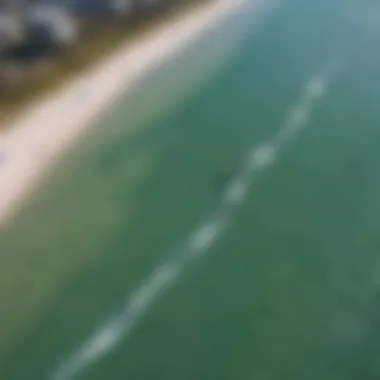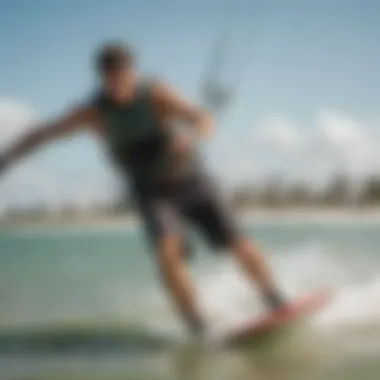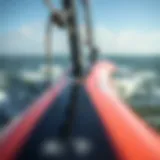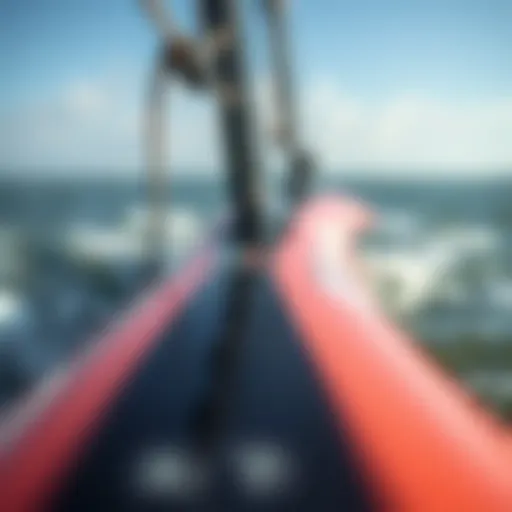Dive into Miami's Thriving Kiteboarding Community


Intro
Miami stands as a gem for kiteboarding, with its sun-kissed beaches and breezy weather. For those passionate about gliding on the waves, city offers not just stunning scenery but also a booming community. This article dives into the nitty-gritty of kiteboarding in Miami. We’ll explore equipment insights, techniques, and the vibrant culture that sets this locale apart. Whether you're just starting your journey or have been riding the wind for years, there's a wealth of information for everyone.
Equipment Insights
Equipment is crucial for any kiteboarder. The right gear not only enhances performance but also ensures safety in the ever-changing ocean environment. In Miami, where the kiteboarding scene thrives, the latest gear is at your fingertips, catering to both beginners and experienced riders.
Latest Gear Reviews
When it comes to kiteboarding, having dependable and high-quality equipment can make the difference between a thrilling ride and a challenging one. Here are some notable products that are getting attention:
- Kite Model A: Known for its stability, this kite works well for both novices and seasoned riders. Its lightweight design allows for easy control in variable winds.
- Board Model B: This board features a unique flex pattern that provides excellent buoyancy, helping riders to smooth out their landings.
- Harness Model C: Its ergonomic design offers comfort and support during long rides, which is essential for those who spend hours out on the water.
Essential Gear Maintenance
Taking care of your gear is just as important as selection. Maintaining your equipment can extend its lifespan and performance significantly. Here’s how:
- Regular Cleaning: Saltwater can wreak havoc on gear. It's best to rinse your kite and board with freshwater after each session.
- Inspection: Before hitting the water, always conduct a quick check for any rips or tears. A small issue can become a significant problem if left unattended.
- Storage: Store your gear in a cool, dry place, away from direct sunlight. Prolonged sun exposure can weaken the materials, leading to failure.
Technique Exploration
Techniques are the cornerstone of kiteboarding. It’s not just about having the gear; it’s about how you use it.
Beginner Techniques
For those starting out, mastering the basics is essential. Here are some key techniques to focus on:
- Body Dragging: This technique helps you get back to your board after falling. It builds confidence in the water.
- Power Strokes: Learning how to hook into the kite's power zone is crucial. It allows you to gain speed and control.
- Water Starts: This is where the fun begins. A proper water start can get you on the board with minimal hassle.
Advanced Maneuvers
Once you’ve nailed the basics, stepping into more advanced moves is the next challenge. These maneuvers not only elevate your skills but also impress others on the water:
- Jumping: Timing and technique here are key. You'll want to feel the kite's pull at the right moment to launch off the water.
- Kite Loops: This maneuver can add flair to your riding but requires practice. It involves looping the kite during a jump for a thrilling descent.
- Surf Slalom: Combining kiteboarding with surfing elements offers a unique experience, allowing riders to carve through the waves like a pro.
Remember, practice is essential. Every kiteboarder started as a beginner, so don’t be discouraged by setbacks.
Embracing the world of kiteboarding in Miami is more than just riding waves; it's about connecting with a community that loves the sport as much as you do. As you gear up and hit the beach, the spirit of adventure awaits you under Florida’s radiant sun.
Foreword to Kiteboarding in Miami
Kiteboarding in Miami isn't just a sport; it's a lifestyle that embodies the vibrant, sun-soaked spirit of this extraordinary city. With its warm waters and steady winds, Miami provides a canvas for enthusiasts to engage in the electrifying dance between wind and sea. The importance of this section lies in laying the groundwork for understanding how Miami has grown into a premier kiteboarding destination.
Over the years, kiteboarding has witnessed an evolution from its nascent stages into a beloved recreational activity, captivating both locals and visitors alike. Whether you are a rookie trying to catch your first breeze or an experienced rider carving through the waves, the city's unique offerings can cater to everyone. The fusion of seasoned instructors and enthusiastic riders creates a supportive environment, fostering growth and connection among participants of all skill levels. Furthermore, a rich community spirit underlines this activity, making it more than just a solo sport but rather a collective experience.
The Evolution of Kiteboarding
The journey kiteboarding has taken is fascinating, marked by innovation and an ever-expanding community. Initially conceived in the late 1970s and early 80s, the sport has come a long way from the original concepts of using inflatable kites for surfing. Early kiteboarders were often seen using makeshift gear out of necessity, gradually leading to the specialized equipment that exists today.
As technology advanced, so did the sails, boards, and harnesses. The industry saw a boom in the late 90s and 2000s, which made novice enthusiasts dive into the sport more easily. The influx of gear options made it simpler for people to find their niche, whether that was aggressive freestyle tricks or beautiful long-distance cruising. The evolution hasn’t just been technical; the community has also shaped kiteboarding into a social venture.
Why Miami is a Kiteboarding Hub
When it comes to kiteboarding locations, Miami stands apart like a lighthouse in the fog. Its geographic positioning offers year-round conditions that are nearly perfect for the sport. The combination of the Atlantic winds and the shallow waters creates an ideal playground for kiteboarders. Many spots around Miami also host consistent wind strengths, allowing riders to hone their skills without the constant frustration of variable conditions.
Moreover, the local communities around kiteboarding make it even more appealing. Kiteboarding schools and shops are sprinkled throughout the city, with knowledgeable instructors eager to share their expertise. Many kiteboarders find themselves drawn to Miami not only for the thrill of the sport but to connect with a diverse network of fellow riders. As kiteboarding grows in popularity, events and competitions continue to emerge, showcasing the talents and camaraderie of the kiteboarding community.
As we navigate through the contents of this article, you'll find a wealth of information covering local shops, necessary gear, techniques, and the community's vibrant culture. Whether you're looking to take your first ride or become a part of Miami's rich kiteboarding heritage, understanding these foundational aspects sets you on the right path.
Local Kiteboarding Shops
Kiteboarding is not just a sport; it's a way of life in Miami. And at the core of this vibrant community are the local kiteboarding shops. These establishments serve as the epicenter where enthusiasts gather to find gear, gain knowledge, and foster connections with fellow riders. The unique offerings and resources within these shops cater to both newcomers and seasoned pros, playing an essential role in shaping the kiteboarding experience.


Overview of Miami Kiteboarding Retailers
Miami boasts a diverse range of kiteboarding retailers, each offering its own slice of the kite culture. These shops range from large, well-known outlets to smaller, specialized stores. The variety means that shoppers have plenty of options, all serving different needs and preferences. Whether you’re looking for the latest gear or seeking advice about local spots, there’s a retailer ready to assist.
Shop Profiles and Offerings
Popular Kiteboarding Shops
When it comes to popular kiteboarding shops in Miami, few have the reputation that Kite Miami holds. This shop is known for its vast selection of kites, boards, and accessories. The staff not only sells but lives and breathes the sport, often seen stocking up on the newest gear from leading brands. Their key characteristic is an excellent customer service experience, catering to both veteran riders and newbies alike.
One unique feature of Kite Miami is their hands-on approach. They offer demo days that allow potential buyers a chance to test kites and boards before committing to a purchase. This can be hugely advantageous for customers who want to ensure they get gear compatible with their skill level and riding style. However, due to this high demand, it can sometimes be difficult to get a spot during peak times.
Specialized Equipment Stores
On the other side of the spectrum, there are specialized equipment stores like Miami Kiteboarding Co.. While not as vast as the popular shops, they focus on supplying high-end, niche products for advanced kiteboarders. Their key characteristic is the depth of knowledge within their staff, who often have backgrounds as instructors or pro riders. This expertise can help customers find gear suited specifically for their advanced techniques or style.
A distinctive aspect of these specialized shops is their custom fitting service, ensuring that every piece of gear matches the rider’s specifications. This level of personalized service can be a game changer. On the downside, products here can be a bit pricey, perhaps steering budget-conscious shoppers elsewhere.
Online vs. In-store Shopping
The debate of online versus in-store shopping continues, especially in the kiteboarding community. Many are inclined to visit physical stores, appreciating the opportunity to see and touch the equipment before buying. This is particularly true for kites and harnesses, where fit is crucial. An advantage of in-store shopping is getting tailored advice from experts who can quickly address any concerns and provide insights based on the current local weather and conditions.
On the flip side, online shopping platforms such as Amazon offer convenience, often showcasing competitive prices and a broader range of products. Here, customers can browse at their leisure, read reviews, and sometimes access exclusive discounts not found in stores. However, buying gear through online channels can come without the personal touch or advice one might find in local retailers.
Seasonal Offers and Discounts
Kiteboarding enthusiasts keep an eye peeled for seasonal offers that come around, particularly during the transition into summer or post-peak season. Shops often incorporate discounts on last year’s models, making it easier for kiteboarders to snag quality equipment without breaking the bank. In some instances, local retailers might hold flash sales or bundle offers that give customers the chance to save while stocking up for their next adventure.
Essential Equipment for Kiteboarding
Kiteboarding is not just a sport; it’s a lifestyle that breathes adventure and exhilaration. To truly embrace this thrilling activity, understanding the essential equipment becomes key. From selecting the right kite to knowing which board suits your style, every piece of gear plays a pivotal role in your performance and safety. This section breaks down the core components that newcomers and seasoned riders alike must consider when preparing for a session on the water.
Choosing the Right Kite
When it comes to kiteboarding, the kite is your primary tool. Choosing the right one can make or break your experience. Kites come in various shapes, sizes, and types, and the choice depends heavily on your skill level, body weight, and the local wind conditions.
- Types of Kites: There are mainly two types of kites: inflatable and foil. Inflatable kites are ideal for beginners due to their stability and ease of use, while foil kites can perform better in lighter winds and may have a bit of a learning curve.
- Size Matters: The kite's size is often measured in square meters. Generally, lighter riders prefer smaller kites, while heavier riders might need larger ones. In Miami, where winds can be unpredictable, having a couple of different sizes can be beneficial.
In essence, understanding the wind conditions at your chosen location and matching them to the correct kite type and size is fundamental. As you gain experience, the subtle nuances like aspect ratio and leading-edge design will start to matter more.
Harness Options and Their Benefits
Next up on the list is the harness. Many might overlook its importance, but a good harness can greatly enhance your kiteboarding experience. There are two main types of harnesses: waist harnesses and seat harnesses.
- Waist Harnesses: Most popular among riders, waist harnesses offer more freedom in terms of movement. They sit above the hips and allow for a more upright riding position.
- Seat Harnesses: Ideal for those who are new, seat harnesses provide better support for your lower back. They wrap around the thighs, making it harder to pull them up, which can be advantageous for maintaining stability during turbulent sessions.
The choice between these options boils down to personal comfort, style, and riding conditions. Experimenting with both could lead to finding the one that feels just right for your body type and riding habits.
Boards: Sizing and Style Considerations
Finally, let’s talk boards. While they may seem secondary compared to kites, a board dictates how you will glide on the water. Different styles of boards cater to varying riding styles—such as freestyle, wave riding, or all-around.
- Sizing: Board sizes vary and are usually expressed in centimeters. As a guideline, lighter riders should opt for shorter boards, while heavier riders may need longer boards for better control. A good rule of thumb is to ensure that the board’s width also supports the kite you’ve chosen.
- Types of Boards: The commonly used shapes include directional and twin-tips. Twin-tips are versatile for beginners, allowing for easy riding in both directions. Directional boards, on the other hand, excel in surf conditions but require more skill to maneuver effectively.
Factors to consider:
- Riding style and conditions
- Personal weight and height
- Skill level and progression goals
Each board will feel different underfoot. Therefore, trying out different boards at local spots, where you can also tap into community advice, can go a long way.
Always remember, investing in quality equipment might seem like a hefty price tag initially, but it pays off in durability and performance.
With a better grasp of the essential kiteboarding equipment, enthusiasts can help ensure their time spent on the beautiful shores of Miami is thrilling and safe. Each gear decision not only enhances the kiteboarding experience but also resonates with the vibrant local culture that makes Miami a paradise for riders.
Kiteboarding Techniques and Safety


Understanding the techniques and safety protocols surrounding kiteboarding is not just important; it is fundamental to enjoying this exhilarating sport. As any seasoned rider knows, kiteboarding combines skill, strength, and an awareness of environmental factors. For novices, mastering the basics can mean the difference between a thrilling experience and a potentially dangerous one. Let's delve deeper into the essential facets that define kiteboarding techniques and the safety measures that ensure a secure ride.
Fundamental Skills for Beginners
Starting off in kiteboarding entails learning a set of core skills that might seem simple at first glance but require practice and precision. Here are some key points:
- Kite Control: It's like learning to dance with the wind. Each movement of the control bar affects the kite's trajectory. Beginners need to spend time flying the kite on land before heading out on the water. This ensures they grasp how wind conditions influence kite handling.
- Body Position: Balance is vital. Riders must find the sweet spot between the power of the kite and their stance on the board. Lean too far back or too far forward, and you risk face-planting in the water.
- Launching and Landing the Kite: A well-executed launch and landing are crucial. A bad launch can result in the kite getting tangled, which can be hazardous. Practicing these techniques with an experienced instructor ensures safety and builds confidence.
"The kite might be in the sky, but your focus should remain on controlling it on the ground first!"
Intermediate Techniques to Master
Once the foundational skills are under the belt, it's time to hone intermediate techniques. These build upon the basic skills but bring in more advanced maneuvers that will enhance a rider’s experience:
- Jumps: Achieving air time can be exhilarating. Riders should master the technique of loading the edge of their board and using the kite's lift. Timing and body positioning are everything here.
- Turns and Transitions: Smooth transitions between direction changes are essential. A solid understanding of edging helps maintain speed and control during these maneuvers. It's not just about turning but doing so while continuing to harness the power of the kite.
- Advanced Board Control: Learning to ride toe-side or perform transitions in tight spaces requires finesse. Riders may also explore freestyle techniques, such as grabs and spins, after mastering the basics.
Safety Protocols While Kiteboarding
Safety can never be overemphasized. Familiarity with safety protocols might not only save lives but significantly enriches the overall kiteboarding experience. Consider the following precautions:
- Wear Appropriate Gear: Always don a properly fitting flotation device. A helmet is also recommended, especially for those practicing jumps or advanced tricks. Additionally, use a wetsuit to protect against cold water and any potential abrasions.
- Know the Conditions: Before heading out, keep an eye on the weather and water conditions. High winds can turn a pleasant day into a perilous situation. Checking local forecasts and tide schedules helps make informed decisions.
- Buddy System: Kiteboarding is often best enjoyed with a partner. Having a buddy not only adds to the fun but also helps ensure that someone is always there to assist in case of emergency.
- Respect the Area: Understanding and following local regulations and guidelines is necessary. Some spots may have restrictions for kiteboarding due to marine life or safety concerns with other beachgoers.
In sum, mastering kiteboarding techniques while adhering to safety protocols is an ongoing process. Each session on the water offers responsibilities and lessons, making the sport increasingly rewarding as one advances. The thrill of flying above the waves is unmatched, but it is the knowledge and preparation that keep the excitement rolling.
The Kiteboarding Community in Miami
Kiteboarding is more than just a thrilling sport in Miami; it's a vibrant culture that binds enthusiasts together. The sense of community is palpable, providing a rich backdrop for both new and experienced riders. Being part of this community means sharing tips, forging friendships, and celebrating each other's successes. In a city where sun and surf collide, the kiteboarding scene fosters an atmosphere of support and camaraderie that is essential for anyone looking to dive deeper into the sport.
Connecting with Local Riders
Joining forces with fellow kiteboarders can significantly enhance your experience. Whether you’re just starting or have logged countless hours on the water, local riders can offer insights that books never will. You might find riding buddies on the popular forums, social media groups, or even at the beaches like Crandon Park or Hobie Beach. Riding with others not only ramps up the fun factor, but it also ensures an element of safety, particularly for novices who might feel overwhelmed at first. Connecting could be as simple as striking up a conversation with someone on the beach or joining local meet-ups organized on platforms like Facebook.
- Local spots to meet other riders:
- Hobie Beach
- Matheson Hammock Park
- Oleta River State Park
Events and Competitions
Several events sprinkle the Miami kiteboarding calendar, creating opportunities for riders to showcase their skills, learn from each other, and celebrate the sport. Competitions range from amateur contests, where up-and-coming kiteboarders test their mettle, to professional leagues that attract the best in the sport. Events like the Miami Kiteboarding Festival not only highlight talent but also draw vendors, local shops, and food trucks, creating a festive atmosphere. The community comes together like family during these gatherings, fostering networking and connections that often last beyond the event itself.
Participating in events can lead to friendships and partnerships that enrich your kiteboarding journey.
Social Media and Online Presence
In today's digital age, social media is a vital part of how the kiteboarding community communicates and organizes. Platforms like Reddit and Facebook serve as the electronic watercoolers for discussions, tips, and shared experiences. Riders often post videos, tutorials, and gear reviews, enhancing the learning experience for beginners. Participating in these online discussions can also keep you informed about local events and sales at kiteboarding shops. A strong online presence doesn't just connect the local scene; it broadens horizons, making it easier to find fellow kiteboarding enthusiasts no matter where you are.
- Key social media spots for kiteboarders:
- Facebook Groups (e.g., Miami Kiteboarding)
- Reddit Community (r/kiteboarding)
The kiteboarding community in Miami is not just a gathering of individuals with shared interests but a thriving ecosystem that thrives on collaboration, camaraderie, and competition. Engaging with local riders, attending events, and leveraging social media can provide enriching experiences that enhance your overall journey in the sport.
Kiteboarding Locations in Miami
Kiteboarding in Miami isn’t just a sport; it’s a lifestyle. The vibrant culture is reflected in the numerous kiteboarding spots scattered across the coast. These locations not only cater to seasoned riders but also provide an accessible gateway for beginners looking to jump into the world of kiteboarding. Selecting the right spot is crucial as it influences the overall experience, from the type of water and wind conditions to the level of crowd control. Each kiteboarding location has its own unique flavor, beckoning enthusiasts to discover new challenges and enjoy breathtaking views.
Best Beaches for Kiteboarding
Miami is famous for its beaches, which serve as prime kiteboarding venues. Here are some standout spots that consistently make the cut:
- Miami Beach: A staple for kiteboarders, Miami Beach offers reliable wind conditions alongside its picturesque landscape. The waters here can be choppy, making it ideal for those wanting to practice skills or simply enjoy the thrill of the ride.
- Key Biscayne: Known for its expansive waters and clear skies, this beach is favored by both beginners and advanced riders. The shallow areas allow for safe learning, while the open waters provide challenging conditions for more experienced kiteboarders.
- Hobie Beach: Located on the south side of Key Biscayne, this gem offers a great mix of space and tranquility. The beach is popular but rarely feels overcrowded, allowing riders to enjoy the sport without interruptions.
The beauty of these beaches lies not just in their physical attributes, but also in the sense of community they foster among riders. It's not unusual to see groups gathering to share tips, tricks, or simply stories from the water.


Hidden Gems and Less Crowded Spots
While the main beaches attract plenty of kiteboarders, sometimes the real treasures are tucked away from the crowds. These hidden spots offer a sense of solitude and often provide a more intimate riding experience:
- Virginia Key: This area is not just about kiteboarding; it has a cult following among nature lovers and water sports enthusiasts. The conditions here are surprisingly good, and you can often find a good breeze without the usual hustle and bustle.
- Crandon Park: Just a short drive from the more populated beaches, Crandon Park offers lovely waters and lush surroundings. The more secluded sections make it a perfect spot for a quiet session, especially during the weekdays.
These hidden gems not only provide an escape from the crowds but also often reveal stunning natural beauty. Kiteboarders who choose these spots frequently leave with greater appreciation for Miami’s coastal diversity.
Weather Conditions and Their Impact
One of the oldest tricks in the kiteboarding book is to keep an eye on the weather. Miami's tropical climate generally boasts reliable wind patterns, yet variability does exist:
- Wind Speed and Direction: Typical wind conditions range from 15 to 25 knots, ideal for most kiteboarding sessions. Southeast trade winds are particularly favorable during the summer months. Understanding these patterns is crucial for planning a successful outing.
- Seasonal Changes: While summer attracts numerous enthusiasts, the winter months can offer some of the best conditions. The cooler winds provide a crisp and exhilarating experience. However, be mindful of fronts, as they can suddenly change conditions.
In essence, weather is a defining factor in kiteboarding success. A clear understanding of local conditions will not only enhance safety but also ensure a more fulfilling experience on the water.
Future Trends in Miami Kiteboarding
Exploring the future trends in kiteboarding, particularly in a vibrant locale like Miami, is vital for both current and aspiring kiteboarders. As the sport evolves, staying updated on innovations, community growth, and environmental practices becomes increasingly important. Recognizing these trends not only enhances the kiteboarding experience but also ensures the sport can grow in a sustainable manner. This section delves into what lies ahead for kiteboarding in Miami, focusing on innovative equipment technology, environmental considerations, and the expected increase in participation.
Innovations in Equipment Technology
The kiteboarding equipment landscape is advancing at a rapid pace. New technologies in materials and design are paving the way for better performance and safety. For instance, manufacturers are investing in lighter, more durable kites made from advanced fabrics. These innovations can drastically improve the aerial performance of the kites, allowing riders to soar with greater ease and precision.
Moreover, boards equipped with smart technology are hitting the market. These boards can feature custom settings that cater to individual rider preferences, optimizing the performance based on weight, skill level, and style. Innovations like these make kiteboarding more accessible to novices while offering seasoned riders the performance upgrades they seek.
- Smaller, foldable kites for easy transport
- Smart boards with responsive tuning features
- Enhanced safety systems integrated into design
Such developments hint at a bright future for kiteboarding, showcasing that technology will enhance not just the sport’s appeal but also its safety.
Environmental Considerations for the Sport
As kiteboarding continues to gain popularity, it’s imperative to address environmental impacts. Miami’s unique coastal ecosystems are under pressure from increased activity. The kiteboarding community is becoming more aware of sustainable practices that can help protect these environments.
The trend toward eco-friendly materials in kite and board production is gaining momentum. Riders are looking for brands that prioritize sustainability, using recycled materials and environmentally friendly manufacturing processes. This shift not only helps preserve local habitats but also appeals to environmentally conscious consumers.
Efforts to minimize the carbon footprint are also becoming commonplace. Many local kiteboarding schools and shops promote practices such as carpooling to spots or organizing group rides to reduce individual vehicular emissions. Additionally, educational campaigns about local ecosystems are being launched, encouraging riders to respect wildlife and natural habitats.
"Adopting sustainable practices allows the kiteboarding community to preserve the beautiful landscapes of Miami while enjoying the thrill of the sport."
Projected Growth of Kiteboarding as an Activity
The outlook for kiteboarding in Miami is bright, with participation expected to rise significantly. This growth is driven by several factors, including enhanced exposure through social media, hosting of international events, and increasing interest among younger generations.
The vibrant kiteboarding culture in Miami attracts not just locals but tourists seeking to immerse themselves in the sport. This influx provides opportunities for emerging schools and retailers who cater specifically to visitors, offering rental equipment and instructional classes.
- Increased social media presence highlights kiteboarding spots and events
- Local and international competitions boost tourism and community engagement
- Youth programs in schools introduce kiteboarding to a younger audience
With the growing interest, one can anticipate a wave of new riders hitting the shores, eager to embrace the thrill of kiteboarding in Miami’s picturesque waters. This growth will likely foster a more diverse community, enriching the kiteboarding culture that makes Miami unique.
In summary, the future trends in Miami kiteboarding revolve around innovative technology, environmental stewardship, and expanding community involvement. By keeping an eye on these developments, riders of all levels can enjoy the sport while contributing positively to its evolution and sustainability.
Culmination and Final Thoughts
In summing up the kiteboarding landscape in Miami, it is clear that this vibrant city offers much more than just a stunning view. The unique blend of suitable weather, diverse beach locales, and a warm, engaging community has made Miami a favorable hotspot for both novices and seasoned riders alike. Understanding the resources available, the essential equipment required, and the passionate culture around kiteboarding is vital for anyone looking to immerse themselves in this exhilarating sport.
Recap of Miami's Kiteboarding Scene
As we've navigated through the various facets of kiteboarding in Miami, several key elements stand out:
- Local Shops: Miami boasts a range of specialized kiteboarding shops where enthusiasts can find both the latest equipment and knowledgeable staff to guide their purchases. This is critical not just for experienced riders looking for upgrades but also for beginners seeking gear tailored to their skill level.
- Techniques and Safety: Essential skills and safety protocols have been emphasized throughout the article, underscoring the importance of becoming proficient and aware to enjoy the sport fully.
- Community Engagement: The kiteboarding community in Miami is not just a collection of individuals; it is a network of support and camaraderie. From competitions to social media interactions, the mutual encouragement among riders is palpable.
In short, Miami's kiteboarding scene is a rich tapestry woven through tradition, innovation, and community spirit.
Encouragement to Explore and Experience
For those contemplating a plunge into kiteboarding, or for seasoned riders curious to explore new horizons, Miami presents a golden opportunity. The thrill of soaring over the waves with the sun on your back and the wind in your hair is an experience that beckons you to the coast.
No matter your skill level, there’s always something fresh to learn or an exciting challenge waiting just beyond the waves.
- Take a Lesson: Beginners should definitely consider booking a lesson to grasp the fundamentals from experienced instructors.
- Join Local Events: Engaging with local events not only enhances your skills but also introduces you to fellow kitesurfers, creating friendships that often extend beyond the water.
- Explore New Spots: While the popular beaches offer their charm, don't shy away from hidden gems scattered around the coast; each spot offers its own unique character and vibe for kiteboarding.







